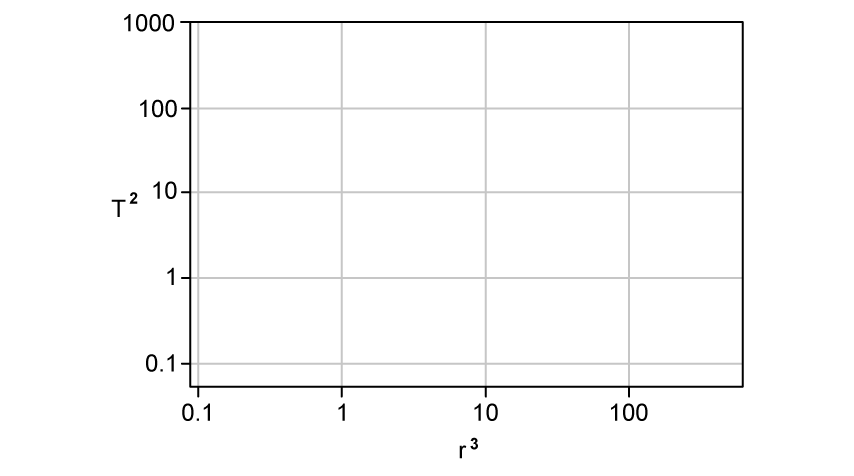The circular motion of a moon in orbit around a planet can be described by:
(a)
Define each of the terms in the equation above and give the unit:
(i)
v
[1]
(ii)
G
[1]
(iii)
M
[1]
(iv)
r
[1]
Assess your score
View Answer
The moon Europa orbits the planet Jupiter at a distance of 670 900 km. The mass of Jupiter is 1.898 × 1027 kg.
(b)
Calculate the linear velocity of Europa.
[3]
Assess your score
View Answer
The mass of Europa is 4.8 × 1022 kg.
(c)
Calculate the gravitational force between Jupiter and Europa.
[2]
Assess your score
View Answer
A second, hypothetical planet orbits Jupiter at a radius twice that of Europa, with the same mass. The gravitational force between two bodies is based on a
(d)
Determine the force between Jupiter and the second planet as a fraction of the the force between Europa and Jupiter.
[2]
Assess your score
View Answer
Previous Question Next Question
(a)
Complete the definition of Kepler's third law using words or phrases from the selection below:
For planets or satellites in a about the same central body, the of the time period is to the of the radius of the orbit.
length mass proportional
[4]
Assess your score
View Answer
Kepler's third law can also be represented by the equation:
(b)
Define each of the terms in the equation above and give the unit:
(i)
T
[1]
(ii)
G
[1]
(iii)
M
[1]
(iv)
r
[1]
Assess your score
View Answer
Venus has an orbital period, T of 0.61 years and its orbital radius, r is 0.72 AU from the Sun.
(c)
Using these numbers, show that Kepler's Third Law,
is true for Venus. No unit conversions are necessary.
[3]
Assess your score
View Answer
Kepler's Third Law
(d)
On the axes below, sketch a graph of
for our solar system, marking on the position of the Earth.
[3 marks]
Assess your score
View Answer
Previous Question Next Question
A satellite orbits the Earth in a clockwise direction.
(a)
Show on the diagram:
(i)
The centripetal force acting on the satellite when it is in orbit, F .
[2]
(ii)
The linear velocity of the satellite when it is in orbit, v .
[2]
Assess your score
View Answer
(b)
State the name of the force which provides the centripetal force required to keep the satellite orbiting in a circular path.
[1]
Assess your score
View Answer
The satellite has a mass of 7000 kg is in geostationary orbit and is constantly fixed above the same point on the Earth's surface. The radius of the geostationary orbit is 42 000 km. The Earth has a mass of 6.0 × 1024 kg.
(c)
Calculate the force required to keep the satellite in this orbit.
[3]
Assess your score
View Answer
All satellites in geostationary orbit are found at the same distance from the centre of the Earth, and are travelling at the same speed.
The equation linking speed of a satellite v and it's orbital radius, r is:
where G is the gravitational constant and M is the mass of the Earth.
(d)
Discuss why the speed is the same for every satellite in geostationary orbit, including the relevance of the satellite's mass.
[2]
Assess your score
View Answer
Previous Question Next Question


